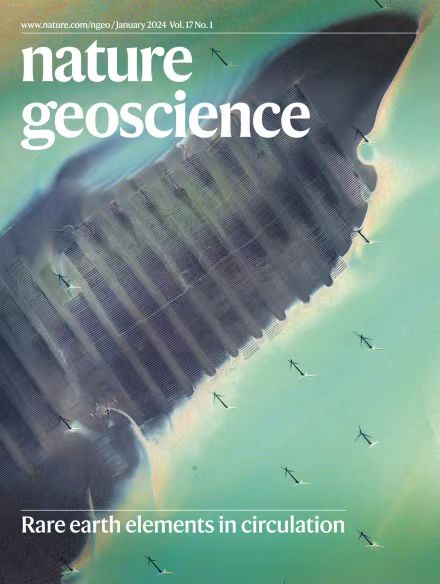Rare earth elements (REEs) such as neodymium, praseodymium, dysprosium, and terbium, play a crucial role in the manufacturing of various technologies that are essential for low-carbon energy and transportation systems. Given the limited supply from in-ground REE mines, circular economy strategies have gained attention as potential solutions to address supply chain issues. However, the specific impacts of these strategies on global REE supply and demand landscape remain largely unmeasured.
A recent study, published and featured on the cover of Nature Geoscience, presents an integrated model to explore the complex linkages between REE and climate pledges, and further quantify the potential of circular economy strategies to reshape global supply chains of critical REEs.
The study is performed by researchers from the Institute of Urban Environment of the Chinese Academy of Sciences, Peking University, Newcastle University, Leiden University, and other institutions. On the top of their previous studies regarding RE sustainability, they develop a novel model called DIRECCT (Dynamic Integrated Model of Rare Earth Circularity and Climate Target) to analyze the effects of circular economy strategies on global REE supply and demand. The model considers both in-ground stocks and in-use stocks, as well as their dramatic geographic shift across ten regions from 2001 to 2050 under three widely-accepted climate scenarios.
The researchers find a significant mismatch between in-ground stocks, supply, and demand at specific regional and element levels, highlighting the heavy rare earth elements such as dysprosium and terbium would pose a major obstacle to achieving net-zero emission targets. In particular, the ongoing consumption of RE in low-carbon products can substantially reallocate REE from the supplying regions like China to consuming regions such as the EU, United States, etc. As in-ground stocks decline among mineral suppliers, the accumulation of in-use stocks in those consuming regions can foster a more balanced global REE supply landscape.
The study highlights the crucial roles of circular economy strategies, including reduction, substitution, reuse, and recycling, in reshaping global REE supply chains. The implementation of these strategies will lead to an increase in RE supply from urban mines within the next three decades, which can significantly reduce the dependency on REE in-ground mines. Some regions like EU might also achieve a closed-loop RE supply with the implementation of circular economy strategies.
Through the integrated modelling of dynamic diffusion of in-use stocks from in-ground stocks, this study offers a new insight into the geopolitical chessboard of critical raw material. Their findings provide valuable insights into the potential impacts of circular economy strategies on REE regional disparities, geopolitical dynamics, and climate goals, which can serve as the scientific basis for international cooperation in promoting the circular economy strategies of REE for global just low-carbon transitions.

The roles of different circular economy strategies in the shift of in-ground minerals to in-use stocks for global low-carbon transition (Image by WANG Peng).

Contacts:CHEN Weiqiang
E-mail:wqchen@iue.ac.cn
Nature Geoscience
link: